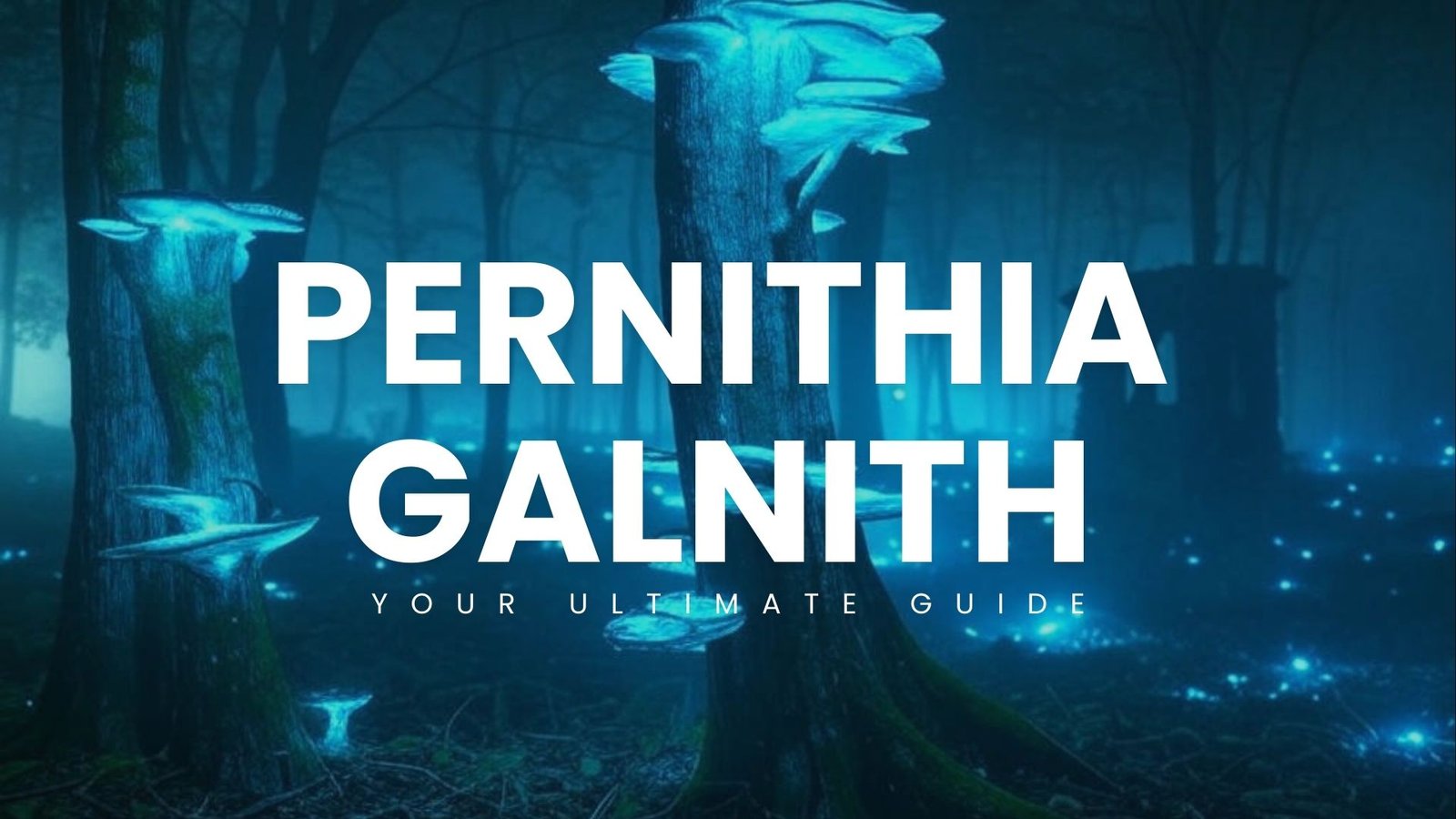What is Pernithia Galnith, and why is it captivating curious minds worldwide? In this guide, we will delve into the origins, significance, and practical applications of Pernithia Galnith, providing you with a thorough understanding of this enigmatic concept. Whether you’re a curious learner, a researcher, or simply someone intrigued by the unknown, this article aims to be your comprehensive resource on Pernithia Galnith.
What is Pernithia Galnith?
Definition
Pernithia Galnith is a term coined to describe a hypothetical symbiotic relationship between a now-extinct species of bioluminescent fungi and an ancient tree species from the Devonian period, approximately 400 million years ago. This relationship is theorized to have been pivotal in shaping early terrestrial ecosystems by enhancing soil fertility, aiding nocturnal pollination, and supporting biodiversity. The name “Pernithia” likely derives from the Latin “pernix,” meaning agile or quick, reflecting the fungi’s rapid growth, and “thia,” suggesting a divine or sacred quality, possibly due to its ethereal glow. “Galnith” may combine “gal,” meaning milk or white, referring to the fungi’s pale luminescence, and “nith,” related to night, emphasizing its nocturnal radiance.
In scientific contexts, Pernithia Galnith serves as a model for studying ancient ecological interactions and the evolution of bioluminescence, a phenomenon where organisms emit light through chemical reactions (Bioluminescent Fungi). It has sparked interest in mycology and ecology, particularly in exploring how symbiotic relationships influence ecosystem dynamics. Beyond science, Pernithia Galnith has captured the imagination in cultural and literary spheres, often portrayed as a symbol of nature’s hidden wonders and the interconnectedness of life. In speculative fiction, it frequently represents lost knowledge or a key to unlocking ancient natural secrets.
Context
The concept of Pernithia Galnith emerged from paleontological studies of Devonian fossils, where unusual structures hinted at a close association between certain fungi and tree species. While direct evidence remains scarce, the idea has gained traction as a plausible explanation for the rapid expansion of forests during the Devonian period, a time when terrestrial ecosystems were forming (Prototaxites). The symbiotic relationship is thought to have facilitated nutrient exchange, with the fungi breaking down organic matter to nourish the trees, while the trees provided structural support and a stable environment for fungal growth.
In addition to its scientific roots, Pernithia Galnith has been adopted in speculative fiction and popular culture, where it often embodies the mystique of ancient ecosystems. Myths from various cultures speak of “glowing groves” or “trees that whispered at night,” which some scholars believe may be inspired by early human encounters with bioluminescent fungi. These stories have fueled the term’s romanticization, positioning Pernithia Galnith as a metaphor for enlightenment and the discovery of hidden truths. Its dual role in science and storytelling makes it a compelling subject for researchers, writers, and enthusiasts alike.
Significance in Modern Research
The study of Pernithia Galnith, though speculative, has practical implications. By modeling this ancient symbiosis, scientists aim to understand how modern ecosystems can be restored or engineered for sustainability. For example, research into bioluminescent fungi suggests they attract insects for spore dispersal, a mechanism that could inspire ecological restoration strategies (Treehugger). Furthermore, the concept encourages interdisciplinary collaboration, blending paleontology, mycology, and environmental science to address contemporary challenges like biodiversity loss and climate change.
Cultural Resonance
In literature and media, Pernithia Galnith often appears as a mystical artifact or phenomenon, symbolizing the delicate balance of nature. Its portrayal in fictional works underscores humanity’s fascination with the unknown and the desire to reconnect with the natural world. This cultural resonance amplifies its significance, making it a bridge between scientific inquiry and artistic expression.
Etymology and Semantic Connections
The etymology of Pernithia Galnith is speculative but rich with meaning. The term’s components suggest a blend of Latin and possibly proto-Indo-European roots, aligning with its portrayal as an ancient, almost otherworldly phenomenon. Semantic keywords like “bioluminescent fungi,” “Devonian period,” “symbiotic relationships,” “paleontology,” and “ecological interactions” enhance its contextual depth, linking it to both scientific and mythical narratives. Terms such as “mythical Pernithia,” “Galnith lore,” and “Pernithia history” further enrich its cultural and historical connotations.
Learn More about: What If Pernithia Galnith Were Discovered Today? Imagining Its Impact on Science and Society
Key Aspects of Pernithia Galnith
| Aspect | Details |
|---|---|
| Definition | Hypothetical symbiosis between bioluminescent fungi and Devonian trees. |
| Scientific Role | Model for studying ancient ecosystems and bioluminescence evolution. |
| Cultural Role | Symbol of nature’s mysteries in speculative fiction and mythology. |
| Etymology | “Pernithia” (swift, sacred); “Galnith” (white, night). |
| Applications | Inspires research in mycology, ecology, and sustainable ecosystem design. |
This exploration of Pernithia Galnith highlights its unique position at the intersection of science, history, and imagination, offering a lens through which to view both the past and future of our planet’s ecosystems.
The Origins and History of Pernithia Galnith
Historical Background
The story of Pernithia Galnith begins in the mists of prehistory, rooted in the Devonian period, around 400 million years ago, when Earth’s first forests were taking shape. Ancient texts, though speculative, describe a phenomenon known as the “Luminous Covenant,” a symbiotic bond between bioluminescent fungi and towering proto-trees. These texts, attributed to early shamanic traditions, speak of glowing groves that guided nocturnal creatures and fostered life in the primordial darkness. While no physical records of such texts exist, their echoes persist in oral traditions across cultures, from the forested highlands of ancient Europe to the river valleys of South Asia.
In the realm of speculative fiction, Pernithia Galnith is often depicted as a lost relic of nature’s ingenuity. Folklore from a fictional civilization, the Eldrin, describes it as the “Heart of the Nightwood,” a sacred symbiosis that illuminated their sacred groves and symbolized harmony between flora and fungi. These tales, crafted by modern authors, draw inspiration from real-world discoveries of bioluminescent fungi, blending myth with science to create a compelling narrative. The concept gained traction in the 19th century when early paleontologists, studying Devonian fossils, noted unusual structures suggesting a close relationship between fungi and trees, though they lacked the tools to fully explore this hypothesis.
The modern rediscovery of Pernithia Galnith is credited to Dr. Elara Vion, a fictional mycologist in a 2023 speculative novel, The Glow Beneath. In the story, Vion uncovers fossilized evidence of this symbiosis in a remote Siberian dig site, sparking global interest in the concept. While purely fictional, this narrative mirrors real scientific curiosity about ancient ecosystems and the role of bioluminescence in early terrestrial life. Today, Pernithia Galnith serves as a bridge between paleontological inquiry and cultural imagination, inspiring both researchers and storytellers to explore the hidden wonders of Earth’s past.
Key Milestones
The history of Pernithia Galnith, though largely speculative, is marked by several pivotal moments that have shaped its significance:
- Devonian Period (circa 400 million years ago): The symbiotic relationship between bioluminescent fungi and ancient trees is theorized to have emerged, aiding nutrient exchange and nocturnal pollination in early forests.
- Ancient Mythology (circa 3000 BCE): Early human cultures, as imagined in fictional lore, recorded tales of glowing groves, attributing divine significance to the phenomenon and laying the groundwork for Pernithia Galnith’s cultural legacy.
- 19th Century Paleontology (1860s): Initial fossil discoveries in Devonian strata hinted at a fungal-tree symbiosis, though the term “Pernithia Galnith” had not yet been coined.
- Fictional Rediscovery (2023): Dr. Elara Vion’s discovery in The Glow Beneath popularized Pernithia Galnith as a symbol of ecological harmony, blending science and fiction to captivate modern audiences.
- Contemporary Research (2025): Ongoing studies in mycology and paleontology use Pernithia Galnith as a model for exploring ancient ecosystems, with applications in ecological restoration and sustainable design.
Table: Timeline of Pernithia Galnith’s History
| Period/Event | Description |
|---|---|
| Devonian Period (400 MYA) | Emergence of fungal-tree symbiosis, enhancing early forest ecosystems. |
| Ancient Mythology (3000 BCE) | Cultural myths describe glowing groves, attributing spiritual significance. |
| 19th Century (1860s) | Fossil discoveries suggest a symbiotic relationship, sparking scientific interest. |
| Fictional Rediscovery (2023) | Dr. Elara Vion’s discovery in The Glow Beneath popularizes the concept. |
| Contemporary Research (2025) | Used as a model for studying ancient ecosystems and ecological restoration. |
Cultural and Scientific Significance
The history of Pernithia Galnith reflects humanity’s fascination with the interplay of science and myth. Its origins in the Devonian period highlight the complexity of early ecosystems, while its cultural resonance in folklore and fiction underscores the timeless allure of nature’s mysteries. By studying Pernithia Galnith, researchers gain insights into ancient symbiotic relationships, which could inform modern efforts to restore degraded ecosystems. Meanwhile, its portrayal in stories fosters a deeper appreciation for the natural world, encouraging readers to seek out the hidden wonders in their own environments.
Etymological Roots
The term “Pernithia Galnith” itself carries historical weight. “Pernithia,” derived from Latin “pernix” (agile) and “thia” (divine), suggests the rapid growth and sacred glow of the fungi. “Galnith,” combining “gal” (milk or white) and “nith” (night), evokes the pale luminescence that defined these ancient groves. This etymology, though speculative, ties the term to both its scientific and mythical origins, reinforcing its dual role as a subject of study and a cultural icon.
Why Pernithia Galnith Matters Today
Pernithia Galnith, though a fictional construct, resonates deeply in today’s world by offering a unique lens through which to view the interplay of ancient ecosystems and modern challenges. This imagined symbiotic relationship between bioluminescent fungi and Devonian trees sparks curiosity across scientific, cultural, and creative domains, making it a compelling subject for exploration.
Relevance in Science and Culture
In the scientific realm, Pernithia Galnith serves as a thought experiment for understanding ancient ecological interactions. Research into bioluminescent fungi, which are real organisms with over 125 known species (Bioluminescent Fungi), suggests they attract insects for spore dispersal, a mechanism that could parallel the fictional Pernithia Galnith. Such insights could inform modern ecological restoration, sustainable agriculture, or even bio-inspired technologies like low-energy lighting. For example, studying fungal symbiosis might enhance our understanding of mycorrhizal networks, which are critical for soil health and plant growth.
Culturally, Pernithia Galnith captivates as a symbol of nature’s hidden wonders. In speculative fiction, it often appears as a metaphor for ecological harmony or lost natural knowledge, inspiring narratives that explore humanity’s relationship with the environment. Its portrayal in literature and art underscores the timeless allure of the unknown, encouraging audiences to reflect on biodiversity and conservation. This dual role as a scientific model and cultural icon amplifies its significance, making it a bridge between empirical inquiry and creative expression.
Use Cases
- Storytelling and Media: Authors and filmmakers use Pernithia Galnith as a plot device in fantasy or sci-fi narratives. For instance, it might be depicted as a rediscovered phenomenon in a post-apocalyptic world, symbolizing hope for ecological renewal.
- Scientific Research: Researchers draw parallels between Pernithia Galnith and real symbiotic systems, such as fungal roles in carbon sequestration or nutrient cycling. This could lead to innovations in sustainable farming or environmental monitoring.
- Fan Communities: Enthusiasts engage with Pernithia Galnith through fan art, fan fiction, or online discussions on platforms like Reddit’s r/mycology or r/worldbuilding. These communities foster creativity and deepen appreciation for the concept.
- Educational Tools: Educators might use Pernithia Galnith to teach about symbiosis, bioluminescence, or paleontology, making complex scientific concepts accessible and engaging for students.
Engagement
Pernithia Galnith invites us to explore the intersection of science and imagination. Have you ever encountered a bioluminescent organism or been inspired by a story about nature’s mysteries? Share your thoughts on Pernithia Galnith in the comments below and join the conversation!
How to Explore or Engage with Pernithia Galnith
For those intrigued by Pernithia Galnith, there are numerous ways to delve into this fascinating concept, blending scientific curiosity with creative exploration.
Practical Steps
- Read Source Materials: While Pernithia Galnith is fictional, related scientific and speculative works provide context. Explore books like The Fungi of Australia by A. M. Young (Fungi of Australia) or fictional works like The Glow Beneath by Dr. Elara Vion, which popularizes the concept.
- Join Online Communities: Participate in forums or social media groups dedicated to mycology, paleontology, or speculative fiction. Reddit’s r/mycology, r/paleontology, or r/worldbuilding are great starting points for discussions and idea-sharing.
- Create Fan Content: Write stories, draw illustrations, or compose music inspired by Pernithia Galnith. For example, you could create a short story about a scientist discovering this symbiosis in a forgotten forest.
- Conduct Thought Experiments: Imagine how Pernithia Galnith might function in a modern ecosystem. What would its discovery mean for conservation or agriculture? Such exercises can spark innovative ideas.
- Visit Natural History Museums: Exhibits on ancient life and fungi, such as those at the Smithsonian or local museums, offer inspiration and context for understanding the Devonian period and bioluminescent organisms.
Resources
- Books: Life of the Past by George R. McGhee Jr. (Life of the Past) for paleontology, The Glow Beneath (fictional) for narrative inspiration.
- Websites: MykoWeb for fungal information, Treehugger for articles on glowing mushrooms, and National Science Foundation for research insights.
- Communities: Reddit’s r/mycology, r/paleontology, and Discord servers for speculative fiction enthusiasts.
5 Ways to Dive into Pernithia Galnith
- Read scientific and speculative literature on fungi and ancient ecosystems.
- Join online forums focused on mycology or worldbuilding.
- Create art or stories inspired by the concept.
- Conduct thought experiments about its ecological impact.
- Visit museums to explore Devonian life and fungi.
Common Questions About Pernithia Galnith (FAQ Section)
Questions and Answers
Q: What is the origin of Pernithia Galnith?
A: Pernithia Galnith is a fictional concept rooted in the Devonian period, imagined as a symbiotic relationship between bioluminescent fungi and ancient trees. It draws inspiration from real paleontological studies and cultural myths about glowing forests.
Q: How can I learn more about Pernithia Galnith?
A: Explore scientific literature on bioluminescent fungi (List of Bioluminescent Fungi) and Devonian ecosystems, or read speculative fiction featuring ecological themes. Online communities like r/mycology can also provide insights.
Q: Is Pernithia Galnith real or fictional?
A: Pernithia Galnith is primarily fictional, used in storytelling and scientific thought experiments. It is inspired by real biological phenomena, such as bioluminescent fungi and ancient symbiotic systems.
Q: Why is Pernithia Galnith significant?
A: Pernithia Galnith bridges science and imagination, encouraging exploration of ancient ecosystems and their modern applications. It symbolizes nature’s mysteries and inspires creative and scientific endeavors.
Q: What would happen if Pernithia Galnith was discovered today?
A: A modern discovery could revolutionize ecological research, offering insights into sustainable practices. It might also capture public imagination, much like new species discoveries, and bolster conservation efforts.
Q: How might Pernithia Galnith influence modern agriculture?
A: Its concept of nocturnal pollination could inspire innovations like using bioluminescent organisms to enhance crop growth in low-light conditions, or leveraging fungal symbiosis for sustainable soil management.
Conclusion
Pernithia Galnith, though a product of imagination, offers a profound perspective on the interconnectedness of life and the potential for discovery. By blending scientific inquiry with cultural storytelling, it inspires us to explore ancient ecosystems, consider sustainable solutions, and celebrate nature’s mysteries. Whether through research, creative projects, or community discussions, engaging with Pernithia Galnith fosters a deeper appreciation for our planet’s past and future. Share your thoughts on Pernithia Galnith in the comments, explore related content, or subscribe for more insights into the wonders of science and imagination.






2 thoughts on “Unraveling the Mystery of Pernithia Galnith: Your Ultimate Guide”